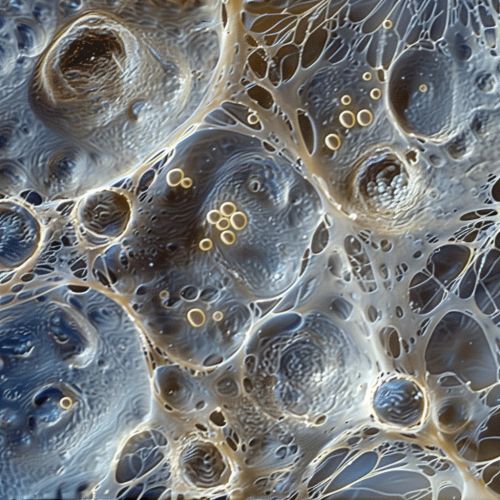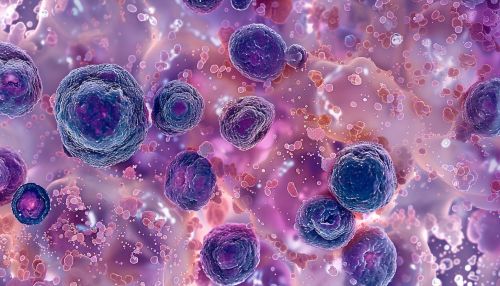Mesenchyme: Difference between revisions
No edit summary |
No edit summary |
||
| Line 31: | Line 31: | ||
* [[Cancer Metastasis]] | * [[Cancer Metastasis]] | ||
[[Image:Detail-91705.jpg|thumb|center|Microscopic image of mesenchymal cells in a rich extracellular matrix.]] | [[Image:Detail-91705.jpg|thumb|center|Microscopic image of mesenchymal cells in a rich extracellular matrix.|class=only_on_mobile]] | ||
[[Image:Detail-91706.jpg|thumb|center|Microscopic image of mesenchymal cells in a rich extracellular matrix.|class=only_on_desktop]] | |||
== Categories == | == Categories == | ||
Latest revision as of 01:01, 20 June 2024
Introduction
Mesenchyme is a type of undifferentiated connective tissue found primarily in the embryonic stage of development. It plays a crucial role in the formation of various tissues and organs in the body, including the skeletal system, circulatory system, and connective tissues. Mesenchyme is characterized by its loosely organized cells embedded in a rich extracellular matrix, which allows for significant cellular movement and differentiation.
Cellular Composition
Mesenchymal cells are multipotent stromal cells that can differentiate into a variety of cell types, including osteoblasts, chondrocytes, myocytes, and adipocytes. These cells are spindle-shaped and possess a high degree of plasticity, which is essential for their role in development and tissue repair. The extracellular matrix of mesenchyme is composed of collagen fibers, proteoglycans, and glycoproteins, providing a supportive environment for cellular activities.
Developmental Role
Mesenchyme originates from the mesoderm, one of the three primary germ layers formed during embryogenesis. It is involved in the formation of the mesodermal tissues, including the musculoskeletal system, cardiovascular system, and connective tissues. The process of mesenchymal differentiation is regulated by a complex interplay of signaling pathways, including Wnt, TGF-β, and Notch signaling.
Mesenchymal-Epithelial Transition (MET) and Epithelial-Mesenchymal Transition (EMT)
Mesenchymal-epithelial transition (MET) and epithelial-mesenchymal transition (EMT) are critical processes in development and disease. MET involves the transformation of mesenchymal cells into epithelial cells, which is essential for the formation of organs and tissues. Conversely, EMT is the process by which epithelial cells acquire mesenchymal characteristics, enabling them to migrate and invade tissues. EMT is a key mechanism in wound healing, fibrosis, and cancer metastasis.
Clinical Significance
Mesenchymal stem cells (MSCs) have garnered significant interest in regenerative medicine due to their ability to differentiate into various cell types and their immunomodulatory properties. MSCs are being explored for their potential in treating a wide range of conditions, including osteoarthritis, myocardial infarction, and autoimmune diseases. Additionally, the role of EMT in cancer progression has made it a target for therapeutic interventions aimed at preventing metastasis.
Research and Advances
Recent advances in mesenchyme research have focused on understanding the molecular mechanisms underlying mesenchymal differentiation and plasticity. Techniques such as single-cell RNA sequencing and CRISPR-Cas9 gene editing have provided insights into the gene regulatory networks and signaling pathways involved in mesenchymal development. Furthermore, the development of three-dimensional (3D) culture systems and organoids has enabled the study of mesenchymal-epithelial interactions in a more physiologically relevant context.
See Also


